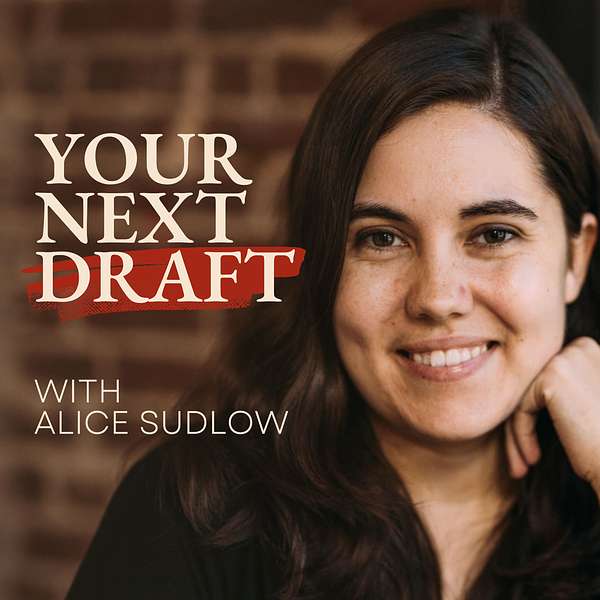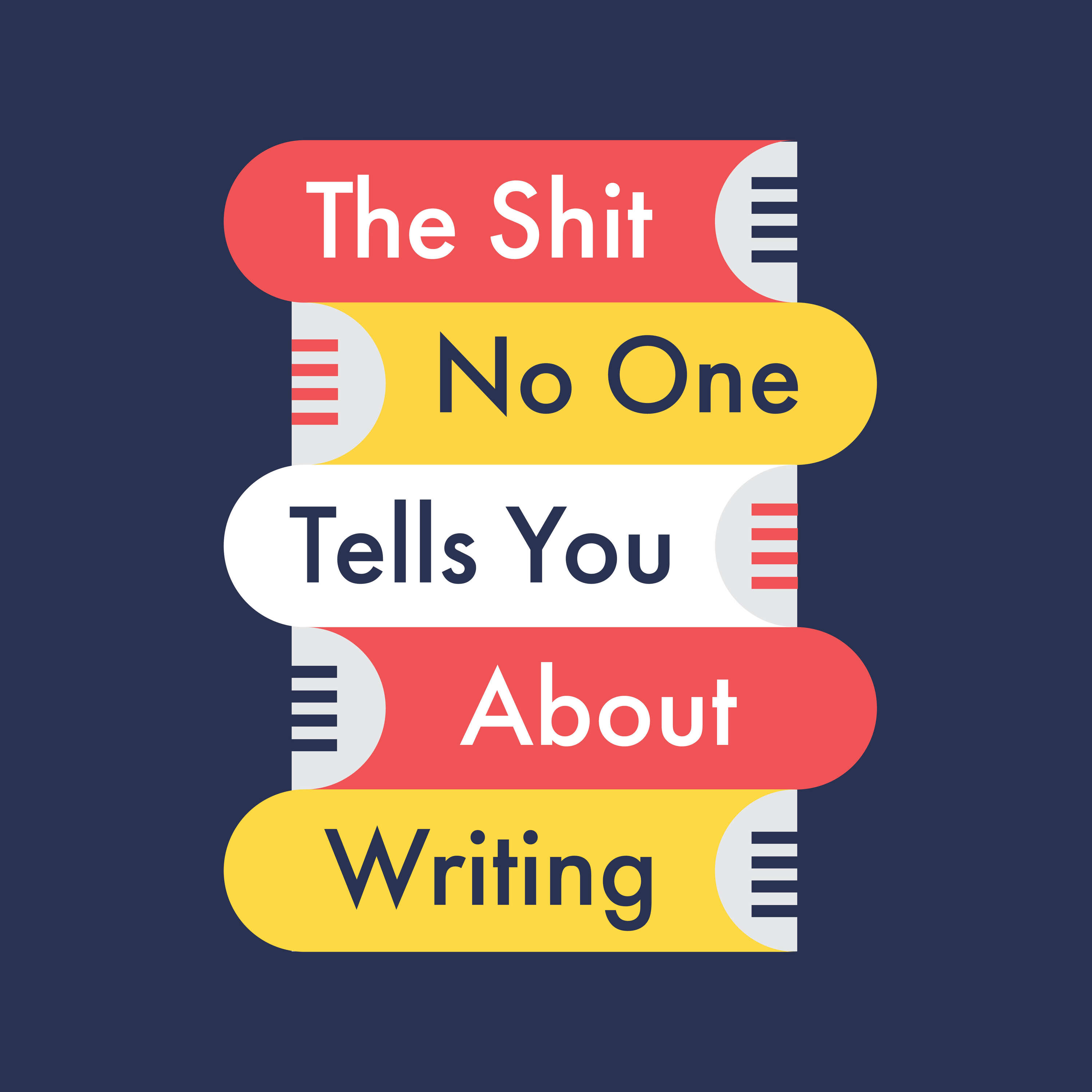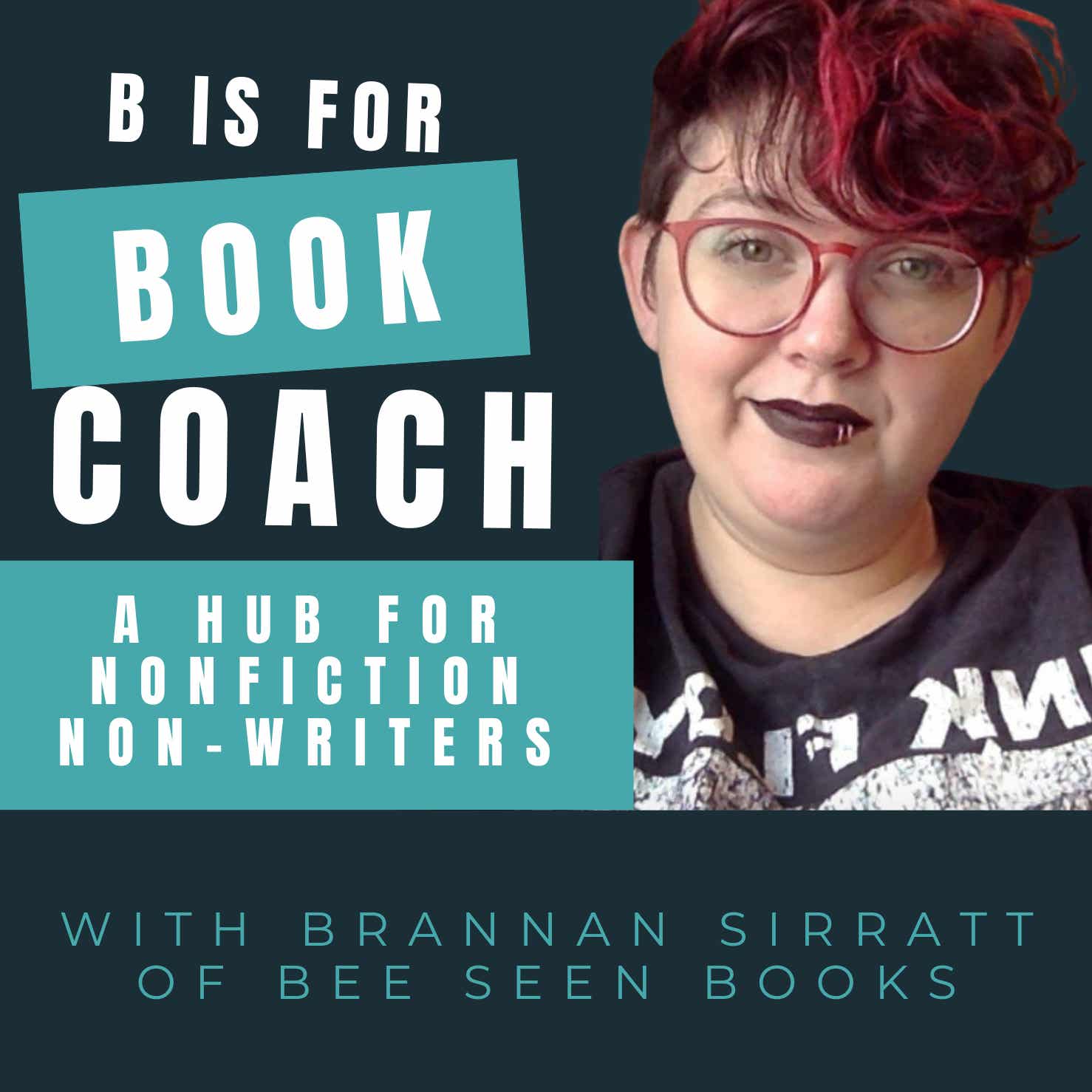
Your Next Draft
Supporting fiction writers doing the hard work of revising unputdownable novels. The novel editing process is the creative crucible where you discover the story you truly want to tell—and it can present some of the most challenging moments on your writing journey.
Developmental editor and book coach Alice Sudlow will be your companion through the mess and magic of revision. You’ll get inspired by interviews with authors, editors, and coaches sharing their revision processes; gain practical tips from Alice’s editing practice; and hear what real revision truly requires as Alice workshops scenes-in-progress with writers.
It’s all a quest to discover: How do you figure out what your story is truly about? How do you determine what form that story should take? And once you do, how do you shape the hundreds of thousands of words you've written into the story’s most refined and powerful form?
If you’ve written a draft—or three—but are still searching for your story’s untapped potential, this is the podcast for you. Together, let’s dig into the difficult and delightful work of editing your next draft.
Your Next Draft
Why the 6 Elements of Story Are the Key to All Great Stories
The story structure framework I use in every story I edit.
What do fractals and nesting dolls have to do with story structure? More than you might think.
Last week on the podcast, I shared my favorite story structure framework. It’s the same structure I use with all my one-on-one clients and in every novel I edit.
But I didn’t tell you why.
Why is it so powerful? Why do I use it in every story? Why do I love it so much that I’m still talking about it on the podcast?
In this episode, you’ll find out.
You’ll learn:
- Why mastering this one story structure will level up your editing on every level of story
- How this structure works for stories from romance to horror and everything in between
- What this structure has in common with fractals—and why that’s fantastic news for your editing
- And more!
If your story’s structure is feeling a little shaky, give these six elements a try. I think they’ll reveal powerful insights about your story.
Links mentioned in the episode:
- Get the Scene Analysis Worksheet: alicesudlow.com/sceneworksheet
- Ep. 27: Value Shifts: How to Craft Compelling Change in Every Story
- Ep. 34: Extended Edition: How Spider-Man’s Leap of Faith Makes Us Feel Triumphant
- Ep. 42: The 6 Essential Elements of Every Novel, Act, and Scene
Rate, Review, & Follow on Apple Podcasts
"I love Alice and Your Next Draft." If that sounds like you, please consider rating and reviewing my show! This helps me support more writers through the mess—and joy—of the editing process. Click here, scroll to the bottom, tap the stars to rate, and select “Write a Review.” Then be sure to let me know what you loved most about the episode!
Loving the show? Show your support with a monthly contribution »
But the great thing about the six elements is that you don't have to be an expert in a bunch of different stories, structure systems in order to edit different parts of your novel. Learn these six elements learn how to craft an arc of change, and you'll be equipped to write and edit any arc of change that appears anywhere in your novel. welcome to your next draft. Great stories are built on great story structure. And last week on the podcast, I shared with you my favorite approach to story structure, it's called the six elements of story. And in that episode, I went through all six elements and broke down how each one contributes to a story arc. But while I mentioned that this is my favorite story structure framework. I didn't tell you why. Why do I love the six elements so much? Why do I find them so useful? Why do I use them with all of my one-on-one clients? That's what I want to share in this episode. You don't have to love them. Like I do. You're under no contractual obligation to love all the things that I love. Although one of the things that I love is editing, and I do hope that in listening to this podcast, you come to love editing at least a little bit too. That said, I think the reasons I'm going to share here are pretty compelling and you might start to see the appeal. So in this episode, I'll start off with a quick recap of the six elements. Then I'll share three reasons why I love this approach to story structure. First up. The recap. Like I said, I did a deep dive into all six elements in last week's episode. If you haven't listened to that episode yet, I highly recommend you check it out after this one, you can find it at our Sobo. hello.com/ 42. And here's the short version. These are the six elements of story. First the inciting incident. Something disrupts the characters normal and kicks off the action of the story. Second progressive complications. The conflict escalates as more complications happen. These events might make things better or worse, but they certainly make things more complicated. Third. The turning point, the largest, most problematic, progressive complication, which forces the protagonist to respond in some way. Fourth. The crisis. In order to respond to the turning point, the protagonist must make a difficult choice. This is a choice between two bad things. Best about choice. Or two good things. Irreconcilable goods. Fifth, the climax, the moment when the protagonist takes action on the crisis, choice and experiences, the consequences. And finally sixth, the resolution. The new normal after the climax, something has changed since the scene began with the inciting incident. And readers want to see what the world looks like now. So there you have it. The inciting incident, progressive complications, turning point crisis, climax and resolution. I use these six elements in literally every single story that I edit. And if you want to see them all written out, I have a free worksheet that you can download. It's called the scene analysis worksheet and you can get it at Alice said, though.com/scene worksheet. So what's so special about all this. Why do I love these six elements so much? Why is the structure so incredibly useful? I have three reasons why I love the story structure and why I recommend it to every writer I work with. First, this story structure is both specific and flexible. It's specific, there are six elements and they each progress in a predetermined order and contribute to the story in a clear and unique way. The structure won't leave you high and dry with no idea what goes in a certain part of the story. Each element serves a specific purpose and leads into the next element. And at the same time, this structure is flexible. It's not so rigidly prescriptive that you're locked into telling just one kind of story. It won't tell you what must happen at each plot point. You can apply it anywhere you want, and it will work. Which brings me to the second advantage of the structure. This structure works for every type of story. No matter your genre, no matter your setting, no matter whether your story is character or plot driven, no matter the age of your readers, this structure will work. Y because stories are about change and these six elements simply describe how one arc of change occurs. At the beginning, things are one way the inciting incident disrupts that one way and the progressive complications escalate that disruption. But really all through this stage, we're still trying to maintain that original beginning state. And then there's a tipping point, a point where things shift. That's the turning point where it becomes impossible to hold on to that beginning state. Now the protagonist is forced to make a choice and take climactic action. And in the aftermath of that action, we're left with a new world order, a new after state things are different now from what they were before. Something has changed. That right. There is one arc of change things start one way and they end another way. And because all stories are about change that arc of change works in every kind of story from romance to horror, to murder, mystery, to anything you can dream of. All you need to know is what changes. What's the world, like, let's start what's the world, like at the end. The way that I think about that change is in terms of value shifts. That's another foundational concept. That's really helpful when it comes to applying these six elements. If that term is new to you, or you'd like to dig deeper into this idea of determining what it is, the changes in your story. I recommend my full episode on value shifts. You can find it@alicesaidthough.com slash 27. And if you know what changes in your story, you can plot the six point arc to take you from start to finish. Which brings me to the third thing that I love about this story structure. The six elements of story are recursive. What in the world does that mean. Well to explain, I first turned to Wikipedia to define recursion. Here's how Wikipedia puts it. Recursion occurs when the definition of a concept or process depends on a simpler version of itself. When I say that the six elements of story are recursive. I mean that they apply at every level of story. They apply on the level of a novel as a whole. You can read a whole book, then identify its inciting incidents, turning point, et cetera. On the scale of the whole book. But if you zoom in and you look closer, you'll find that the six elements appear again. If you divide the story into acts, each act also includes the six elements. And if you zoom in even closer, you'll find that each scene is built on the six elements to. One way to picture. This is like nesting dolls. The story as a whole is a great big doll. But if you pull the top off the doll, you'll find another doll inside. That's the acts of the story. If you open that doll, you'll find another doll inside sequences. If you open that doll, you'll find it another scenes and on and on smaller dolls hidden inside of larger ones. Or another way to picture this is as a fractal. I like to think of the Sierpinski triangle. It's easier to see them to describe. So I'm linking to an image in the show notes, so you can see what I'm talking about, but here goes my stab at describing it. Imagine you have a large equal lateral triangle pointing up. Inside that triangle, there's a medium sized triangle pointing down and each point of that medium triangle touches the sides of the larger triangle. It perfectly divides the larger triangle into four medium triangles. One pointing down in the center and three pointing up one in each corner. And then inside those three triangles pointing up, there's a smaller triangle pointing down that smaller triangle. Again, perfectly divides each medium-sized triangle into four parts, three pointing up, and one of the center pointing down. And it could go on forever. Every time there's a triangle pointing up inside of it. There's a smaller triangle pointing down that subdivides it. And that creates three more triangles pointing up each with a smaller triangle inside of them. The six elements of story are made of. The six elements of story, just at a smaller and smaller scale, the more that you zoom in. Honestly, this right here is my favorite aspect of the structure. No matter which part of your story you're working with, the six elements will help you structure it. And if you discover a hidden opportunity within your story, you can zoom in and apply these six elements there to. A lot of times I'll be working with a scene that's maybe 2000 words or so long. It includes all the six elements at the beginning, there's in the inciting incident. Then there are a few progressive complications. The turning point will happen somewhere in the middle of those 2000 words. And then there's the crisis and the climax and the resolution. It's a full arc of change. And the resolution will be, say 600 words long. Maybe it's a conversation between a couple of characters that sort of rounds out everything that's happened in the scene. And I'll think. Let's conversation is fine, but it could be way more interesting. So I'll pull out the six elements to study those 600 words. And I'll see that within this little segment of story, we have the opportunity to craft another arc of change. That conversation between a couple of characters becomes even more interesting when we identified the value shift, that's changing here and craft a mini turning point crisis and climax within this little interaction. Remember the scene already had the six elements all present and working within it. So if we didn't change the 600 words of resolution at all, the scene would still work. But when I see a space in a story where we can make something even more interesting and make it contribute to the story even more. Why skip it? If you'd like to see this recursive, this at play and see how you can zoom in and out and find the six elements at all levels of story. Go check out episode 34 of your next draft. In that episode, editor Kim Cussler and I analyze a scene from the movie Spiderman into the spider verse and we each have different takes on where the scene starts and ends and on how multiple smaller arcs of change nest within the scene. You can find that episode@alicesubtler.com slash 34. To jump straight to that part of our conversation. Start at one hour, nine minutes in. There's one more wonderful thing about this recursive nature of the six elements that I want to point out to you. Maybe you've spotted it already. If not, you're in for a treat. Since the story structure is recursive. It means that if you learn it, once you have the tools, you need to edit every level of your story. You'll edit your acts, using the same tools that you use to edit your scenes. As you practice editing scenes, you'll develop the same skills that you'll need to edit the structure of the novel as a whole. There's so much story theory out there. So many stories, structure systems that you could learn and they're all great. Plus you can layer them with the six elements of story. For example, you could plot your story. Arc would save the cat, then zoom in and refine your acts and your scenes with the six elements. But the great thing about the six elements is that you don't have to be an expert in a bunch of different stories, structure systems in order to edit different parts of your novel. Learn these six elements learn how to craft an arc of change, and you'll be equipped to write and edit any arc of change that appears anywhere in your novel. So there you have it. Three reasons. I love the six elements of story structure. Here they are again. First, this structure is specific yet. Flexible. It gives you enough structure to guide your story without being overly rigid or prescriptive about what any specific plot points should be. Second. It works for every type of story. These six elements. Describe one arc of change. As long as something changes in your story, this structure will work. And since story is about change, something must change in your story or you don't really have a story. And third and best of all, this structure is recursive. It works at every level of story, like a fractal that just reveals more than more used zoom in. And when you practice applying it at one level of story, you develop storytelling skills that will help you at every level of story. Like I said at the beginning, you don't have to love the structure like I do. There are a lot of ways to think about story structure and the best one for your stories is the one that works for you. This one works for me. I encourage you to give it a try and see what it could look like in your stories. And don't forget, you can download my worksheet with all six elements by going to Alice sedler.com/scene worksheet. Until next week, happy editing.





